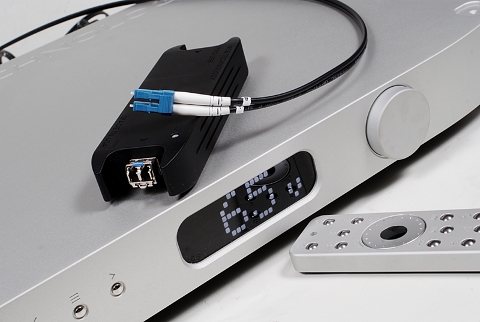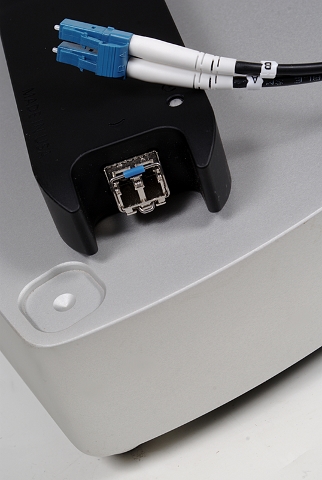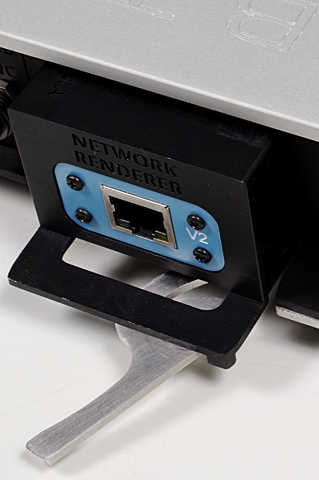about Audio, High Fidelity
& Home Entertainment technologies
pid: 607-2025/10/01 (v1.2)
Privacy Policy

The Discrete has replaced the reference DAC (Teac Esoteric D70) and was connected to all available sources, namely the TEAC Esoteric P70, the computer that plays the role of the USB host and the home network, via Ethernet. Its output was directly connected to the reference power amplifier (Parasound HCA3500, through its Balanced inputs). The loudspeaker used as our standard reference was the ATC SCM-50PSL.
Installation and setup of the device were problem-free as anticipated. The menu is clear and access to the various functions was easy, through the remote control, thanks to the big and legible screen. The only difference between the Discrete and a standard USB DAC one can refer to is that of its USB connection. The host must be connected to the external transcoder and from there the double optical fiber must be used toward the special ProISL input the device offers.
Once all the necessary connections are made, the user may confirm that their system works properly, using a series of special files that he should download from the MSB site, the reproduction of which will confirm the "bit-perfect" capability of the chain.
The first impression you get, listening to the system with the Discrete as a DAC, is that you came up against a top-quality digital device, not just in comparison to the reference DAC, but based on most criteria (and this is something that we don't often encounter). The system appeared extremely transparent, and clear, with an excellent feeling of air, well-balanced, well-controlled, and full low-end, with the result being characterized by a homogeneous feeling of presence that makes the sound enjoyable. These first impressions are complemented, very convincingly by the way the device seems to behave when high-resolution files are streamed, with the higher end of the audio spectrum gaining in naturalness and presence.
Although most of the listening was done at a Network Rendering mode, that is, using the Discrete as a UPnP "Playback Device", listening using a conventional transport (namely the P70 set to 2x upsampling) and through a USB port also proved quite revealing. Through these two inputs, our impressions are, to some extent, similar to these reported in the preceding paragraph, but the biggest difference was through the USB port, a fact that should - most likely - be attributed to the galvanic isolation the ProUSB kit offers, via the optical line.
To the details, the reference system with the Discrete as DAC, offered an excellent bass extension, with a great beat and rhythm description, a very good feeling of scale, and sounded a little airier than the reference, filling the space in an imposing way without creating the impression of a false or unnecessary emphasis.
This behavior seems to extend towards the mid and top low-frequency range, where the volume and size of the acoustic instruments were reproduced with an excellent feeling of balance. The result feels disciplined, not at all babbling or excessive, but strongly present and they will draw the listener's attention as soon as the music starts. The rhythm section is described in perfect scale, sense of fullness and control, creating a natural perception of flow, where the listener easily drifts into foot tapping. The system proved impressive without being dominative, a true balancing act, here.
The mid band appears to be one of the strongest qualities of the device. The listener always remains at the right distance from the sound events, which are described with well-balanced brightness, vibrant and extremely detailed, with a great sense of transparency. The result will never be oppressive, in any way, even at high levels. The presence of the acoustic instruments, the soloists, and the choir has an extremely natural feel, a very good feeling of air and movement, a click better than our reference in both voice articulation and nuances.
In general, the system with the Discrete was noticeably better in conveying the mixing and soundscaping attributes. The very good capacity in detail description has its impact on the stereo imaging performance. Here, Discrete excelled, characterized by a great focusing ability both for individual instruments and groups, a natural, unconstrained description of movement with a top-class sense of depth and feeling of space. All these are elements already noteworthy in the reference system but perceivably improved with the MSB. Moreover, in tracks requiring some serious envelopment capacity, the result was particularly convincing with clear and distinctive source focusing outside the space between the loudspeakers, when needed.
As for the high-frequency part of the audio spectrum, the device demonstrated the features we systematically come across in top digital implementations. Good extension, homogeneity, and transparency are, of course, parts of the whole picture, for a device with a price tag exceeding the €10,000 limit, but the real difference lies in the details. The converter sounded soft, relaxed, without the slightest trace of roughness, and, initially, the unsuspecting listener could consider this behavior somewhat clinical. This is not the case, though, as in a few minutes it becomes clear that the result offers great detail capacity, excellent time features with very good attack/decay and body description, and slightly faster release times compared to the reference. Rich and well-balanced in warmth harmonics are contributing to a vibrant, intense spacial presence of which the listener will never get tired.
Conclusion
I have to admit that there are not many things to be written as a conclusion. The Discrete is one of the best DACs I have reviewed in recent years, with the additional advantage that its design follows a different path than most conventional devices. MSB appears to have done a great job to isolate the factors that affect the performance of a digital converter and this is evident both from the measurements and through the listening tests. The fact that they combined this approach with a modular architecture that offers great flexibility and a series of modules at the same top-quality level, complements the package in a way that cannot be disputed. We are dealing with a reference device that we enthusiastically recommend to anyone who wants to invest at this level.
Listening Sessions Recording
The following recordings were made with a DV-RA1000 Tascam master recorder (using 24bit/192kHz sample rate) and you can download them to have an impression of what the device under review sounded like. It is obvious that any recording of this kind could not be absolutely transparent but, according to our experience, the majority of sound attributes we listen to, during the actual listening sessions, are preserved. No need to say that you should use these samples cautiously and for informative purposes only. Do not rely on them exclusively to make any buying decisions. The file format is .flac, so expect that the zipped files will be quite large (even if the clips are about a minute or less long. You could use an ABX listening tool like the ABX plug-in for foobar2000 if you want to make some more elaborate experiments. Contact us if you have any questions.
| Listening Sessions Recording TOC | |
|---|---|
| Track #01 | MSB Technology The Discrete DAC/Network Renderer V2, XLR Out, 16-bit/44,1kHz. |
| Track #02 | MSB Technology The Discrete DAC/Network Renderer V2, XLR Out, 24-bit/96kHz. |
| Reference | Teac Esoteric D70 | dCS Puccini U-Clock. |
Previous | Next | More Reviews



